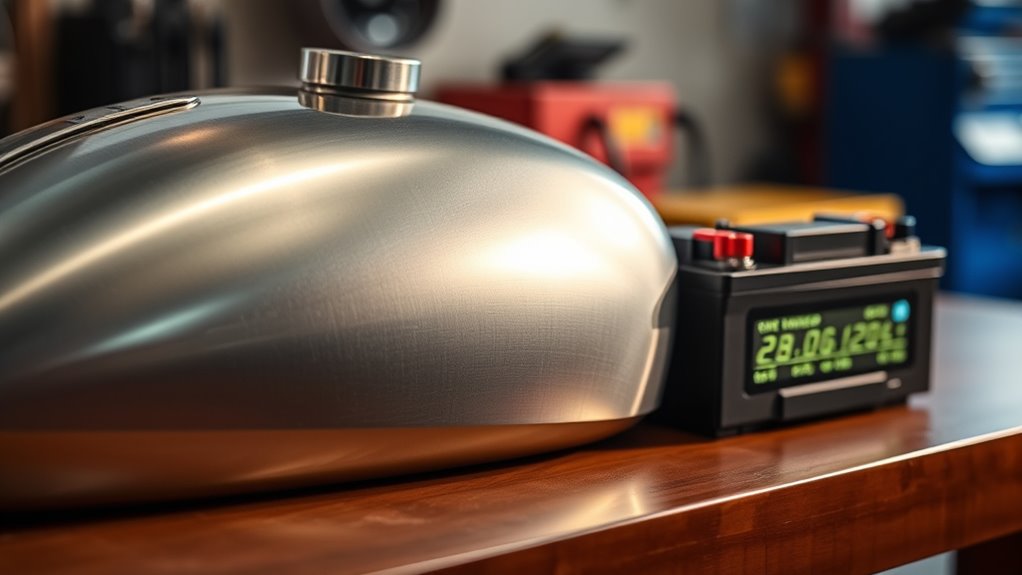To estimate runtime from tank size or battery capacity, first find the total energy stored—convert tank volume to fuel or air volume, or battery capacity to watt-hours. Then, determine your system’s consumption rate. Divide the total energy by this rate to get an approximate runtime. Keep in mind factors like efficiency, depth of discharge, and safety margins for more accurate estimates. Continue exploring for detailed methods and tips.
Key Takeaways
- Calculate runtime by dividing the total capacity (in Ah or Wh) by the load current or power consumption.
- Convert tank volume to usable units (liters or gallons) and determine flow rate to estimate operation duration.
- For batteries, consider depth of discharge, efficiency, and safety margins to refine runtime estimates.
- Use formulas like Runtime = Capacity ÷ Load Current for batteries, and Volume ÷ Flow Rate for tanks.
- Incorporate real-world factors such as temperature, system efficiency, and measurement accuracy to improve estimations.
Understanding the Basics of Runtime Estimation

To estimate the runtime of a device, you need to understand the relationship between its power consumption and the battery or tank size. Runtime can be calculated by dividing the battery capacity by the load current (Runtime = Capacity ÷ Load Current). Alternatively, you can use power: Runtime = (Capacity × Voltage ÷ 1000) ÷ Load Power. Keep in mind that factors like Depth of Discharge (DoD) and efficiency (η) reduce practical runtime; for example, Li-ion batteries typically allow 80–95% capacity usage. Knowing the battery voltage helps convert capacity to watt-hours (Wh), essential for comparing energy to device power ratings. Remember, ignoring energy losses leads to overestimating runtime, so incorporating efficiency and discharge limits gives a more accurate prediction. Additionally, understanding battery lifespan can influence how you plan for consistent device performance over time. Properly accounting for energy efficiency and discharge protocols ensures more reliable runtime estimates. Considering cumulative energy drain from continuous operation is also important for long-term planning. Furthermore, factoring in energy conservation techniques can extend device operation between charges.
Calculating Fuel Tank Volume Based on Shape and Dimensions

To estimate your tank’s volume accurately, you need to understand the formulas for different shapes and how to apply them. Whether it’s a rectangular, cylindrical, capsule, or spherical tank, knowing the correct calculation method is essential. Using precise dimensions and consistent units guarantees your volume estimates are reliable for runtime calculations. Accurate measurement of tank dimensions is crucial because even small errors can lead to significant discrepancies in volume estimations. Additionally, understanding the geometry of the tank helps in selecting the appropriate formula for each shape. When working with Honda vehicle tanks, considering the specific design features can further improve the accuracy of your calculations. Recognizing the importance of material and design considerations can also aid in understanding complex shapes and their volume calculations.
Tank Shape Formulas
Understanding tank shape formulas is essential for accurately calculating fuel or liquid volume based on the tank’s dimensions. For rectangular tanks, you multiply length, width, and height, ensuring all measurements are in consistent units. You can also determine partial fill volumes by replacing the total height with the filled depth. To convert cubic inches or feet into gallons, use the appropriate conversion factors, like 231 cubic inches per gallon. Horizontal cylindrical tanks require calculating the total volume with ( V = pi r^2 l ), then adjusting for partial fills using the circular segment formula. Capsule-shaped tanks combine cylindrical and spherical calculations, summing the respective volumes. For vertical capsules, you analyze fill levels relative to hemispherical sections and cylindrical parts. Mastering these formulas allows you to estimate tank volume precisely based on shape and dimensions, which is crucial for resources and training in industries relying on accurate measurements. Additionally, understanding the tank shape formulas can help optimize storage solutions and improve overall efficiency, especially when considering vetted information for quality assurance. Recognizing the importance of accurate measurements in tank calculations ensures safety and efficiency in various applications.
Accurate Volume Estimation
Accurate volume estimation begins with precise measurements of your tank’s dimensions and careful attention to shape specifics. Use inside dimensions—outer measurements include material thickness, which can skew results. Measure diameter, length, and fill height consistently in meters, millimeters, or inches, then convert all to the same unit system to prevent errors. For partially filled tanks, focus on fill height, as it impacts the liquid volume, especially in curved tanks. For complex shapes, measure individual sections like cylindrical parts and end caps separately for better accuracy. Calculate total volume using geometric formulas: cylinders ((V = pi r^2 l)), rectangular tanks ((l times w times h)), or segments for partial fills. Converting cubic units to liters or gallons ensures clear, usable measurements for estimating runtime effectively. Additionally, considering the shape of the tank is crucial, as different geometries require specific formulas for precise volume calculations. Recognizing the material of the tank can also influence the accuracy of your measurements, especially when accounting for material thickness or deformation over time. Being aware of manufacturing tolerances can further enhance the precision of your volume estimates.
Estimating Diesel Generator Runtime Using Fuel Consumption Rates
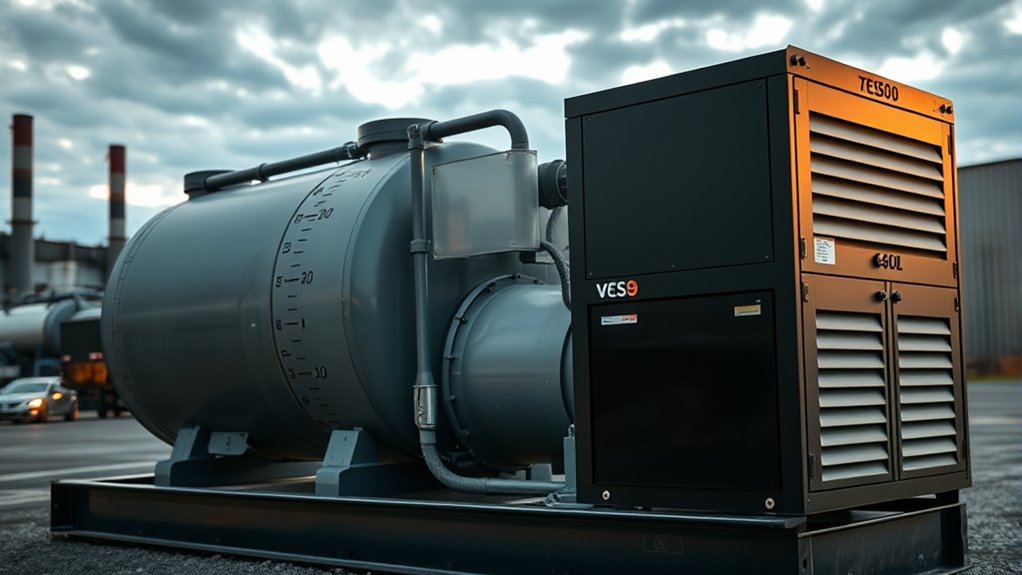
Estimating diesel generator runtime from fuel consumption rates involves calculating how long a given fuel supply can sustain operation at a specific load. To do this, you need the fuel tank capacity and the generator’s fuel consumption rate at your load level. The formula is straightforward: Runtime (hours) = Fuel Tank Capacity ÷ Fuel Consumption Rate (gal/hr or L/hr). Your fuel consumption depends on the load; higher loads increase consumption and reduce runtime. Using manufacturer data or fuel consumption charts, you can estimate burn rates—for example, 200 kW at 0.25 L/kWh results in 50 L/hr. Adjust your calculations based on actual fuel flow measurements and ambient conditions to improve accuracy. Additionally, considering noise levels of modern heat pumps can help ensure your backup generator operates quietly during power outages. Incorporating proper maintenance practices can also extend the effective runtime and reliability of your generator. Regularly monitoring fuel efficiency metrics enables more precise runtime estimates and helps optimize your generator’s performance. Being aware of energy-efficient operation strategies can further enhance your system’s longevity and efficiency. Always consider a safety margin for reliable backup capacity.
Determining Battery Runtime From Capacity and Power Usage

To determine how long a battery can power your devices, you need to relate its capacity to your load’s power consumption. If your load is in watts, use the power-based formula: Runtime (hours) = (Capacity (mAh) × Voltage (V) ÷ 1000) ÷ Load Power (W). For example, a 12 V, 100 Ah battery has a usable capacity of around 1,200 Wh. If your device consumes 50 W, the estimated runtime is about 24 hours, adjusting for system efficiency and safety margins. For loads in milliamps, use the current-based formula: Runtime = Capacity (mAh) ÷ Load Current (mA). Remember, real-world factors like battery chemistry, depth of discharge, and efficiency reduce actual runtime compared to theoretical calculations. Always account for these for more accurate estimates. Additionally, understanding the battery’s capacity and efficiency can help improve the accuracy of your runtime predictions. Considering tuning modifications and their impact on power consumption can also provide a more comprehensive estimate of runtime in real-world scenarios. Moreover, regularly monitoring your device’s actual power usage during operation can help refine your estimates and account for variability in real-world conditions.
Assessing Air Tank Runtime and Fill Time for Compressed Air Systems
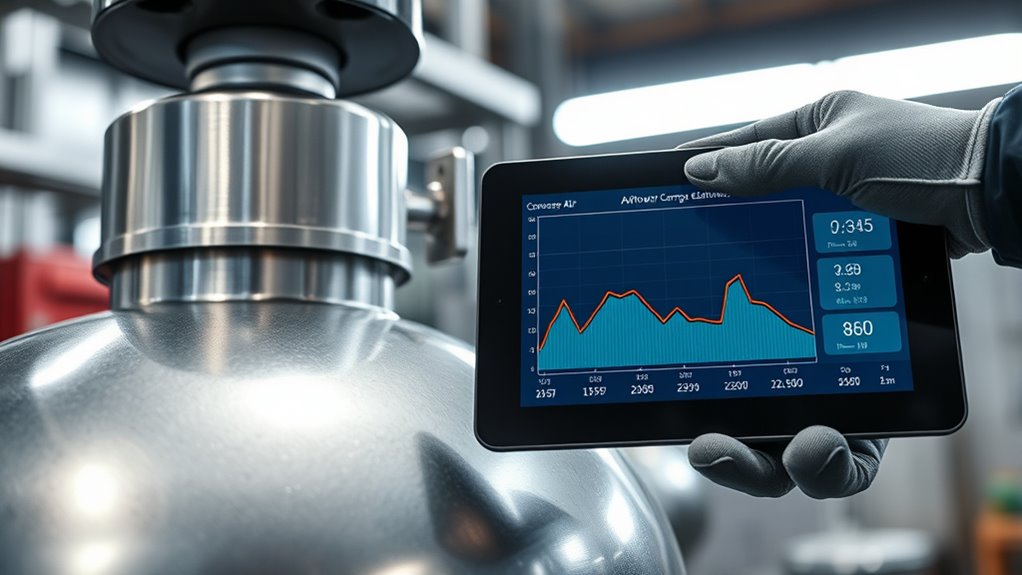
Evaluating the runtime and fill time of an air tank involves measuring the system’s actual performance rather than relying solely on theoretical calculations. First, convert tank volume from gallons to cubic feet by dividing by 7.48. Add atmospheric pressure (14.7 PSI) to gauge pressure to find absolute pressure, then multiply the tank volume by the ratio of absolute pressure to atmospheric pressure to determine total air volume at that pressure. To estimate fill time, divide the volume of air needed by the compressor’s CFM, considering the pressure difference. For example, filling a 100-gallon tank from 0 to 120 PSIG with a 15 CFM compressor takes about 7 minutes. Measuring pump-up time between pressures helps verify compressor output, ensuring accurate runtime and fill time assessments.
Incorporating Safety Margins and Real-World Factors Into Estimates
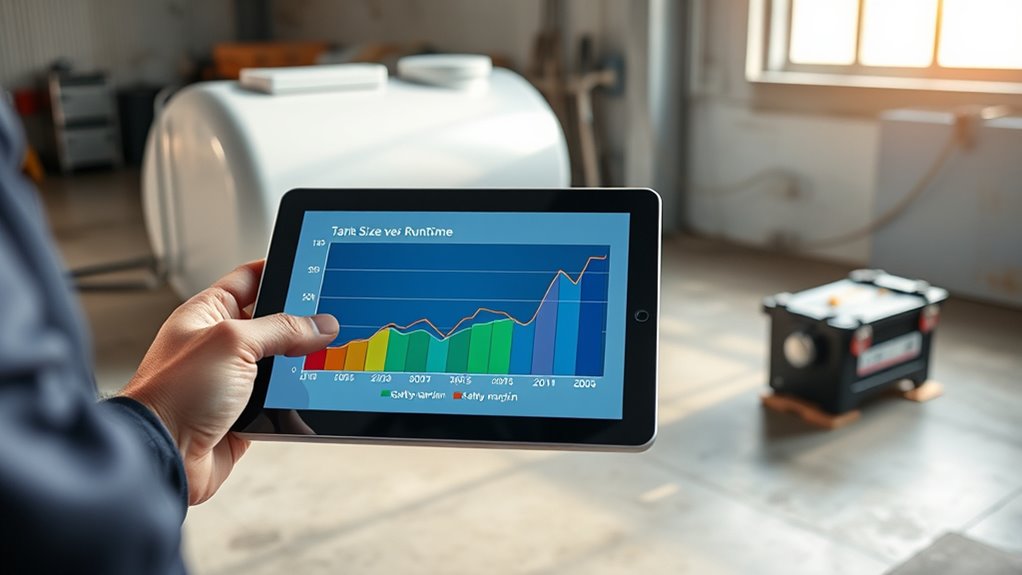
When estimating runtime, you need to include safety margins to account for unexpected conditions or measurement errors. Adjusting for real-world variability—like temperature changes, device usage, or battery aging—helps prevent overestimating capacity. Incorporating these factors guarantees your estimates stay reliable and practical across different scenarios.
Accounting for Safety Margins
Accounting for safety margins is essential to producing realistic runtime estimates that reflect real-world conditions. By including a buffer, you account for uncertainties such as manufacturing tolerances, environmental influences, and usage variability. This prevents overestimating runtime and reduces the risk of unexpected shutdowns. To incorporate safety margins effectively, consider these key points:
- Subtract a percentage of usable capacity based on empirical or manufacturer data.
- Use probabilistic models to account for uncertainties statistically.
- Adjust for environmental factors like temperature and humidity.
- Incorporate aging and degradation effects over time.
These steps help set conservative expectations, ensuring your estimates remain reliable under varying conditions. Properly accounting for safety margins improves system robustness and guides better operational decisions.
Adjusting for Practical Variability
Adjusting for practical variability is essential for producing accurate runtime estimates that reflect real-world conditions. External factors like temperature, humidity, and system wear cause capacity and efficiency changes. Load fluctuations, operational cycles, and transient peaks alter consumption rates, requiring dynamic adjustments. Measurement inaccuracies from sensors, modeling assumptions, and data noise introduce uncertainty, so estimates must account for these errors. Additionally, different usage patterns—continuous or intermittent loads—impact actual runtime. To visualize, consider this:
| Factor | Impact |
|---|---|
| Environmental Conditions | Temperature, humidity, and pressure affect efficiency and viscosity |
| Load and Usage Patterns | Variable loads and duty cycles change consumption rates |
| Measurement & Modeling | Sensor errors, assumptions, and data noise influence accuracy |
Correcting for these factors improves estimate reliability.
Using Standards and Guidelines to Improve Accuracy
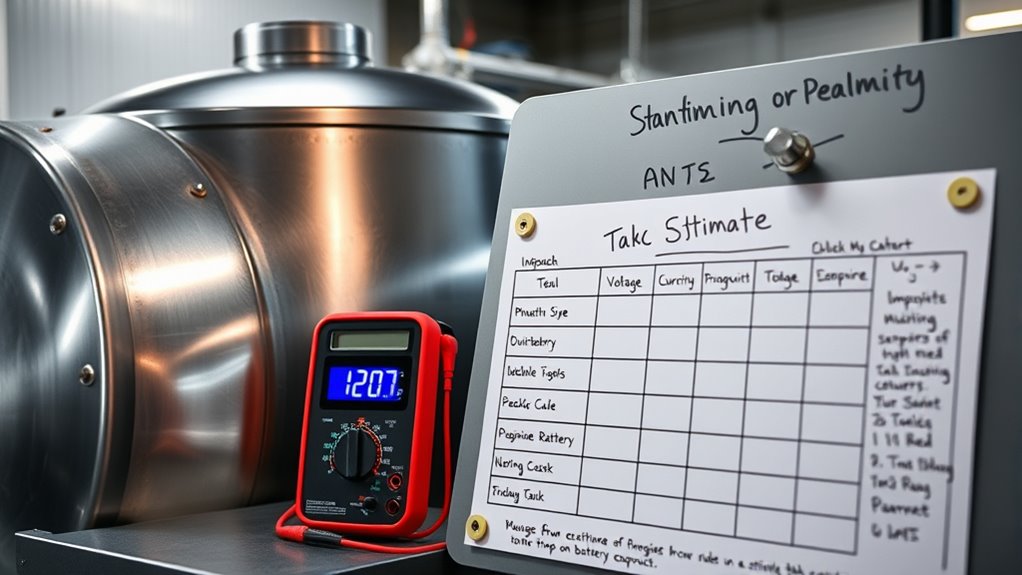
Applying established standards and guidelines is essential for accurately estimating battery runtime because it guarantees that real-world factors like capacity degradation, efficiency losses, and safety margins are properly considered. Following these standards helps you avoid overestimations and enhances system reliability. For example:
Applying standards ensures reliable battery runtime estimates by accounting for degradation, efficiency, and safety margins.
- Oversize batteries by at least 125% of the estimated runtime to account for capacity fade over time.
- Use efficiency factors (around 85–95%) to adjust for system losses during charge and discharge.
- Incorporate DoD limits (such as 80–95%) to prevent premature capacity reduction.
- Apply degradation models to predict capacity loss, ensuring sizing remains valid throughout the battery’s lifespan.
Adhering to these guidelines improves accuracy and ensures your system maintains performance despite aging and operational variations.
Practical Tips for Monitoring and Verifying Runtime Estimates
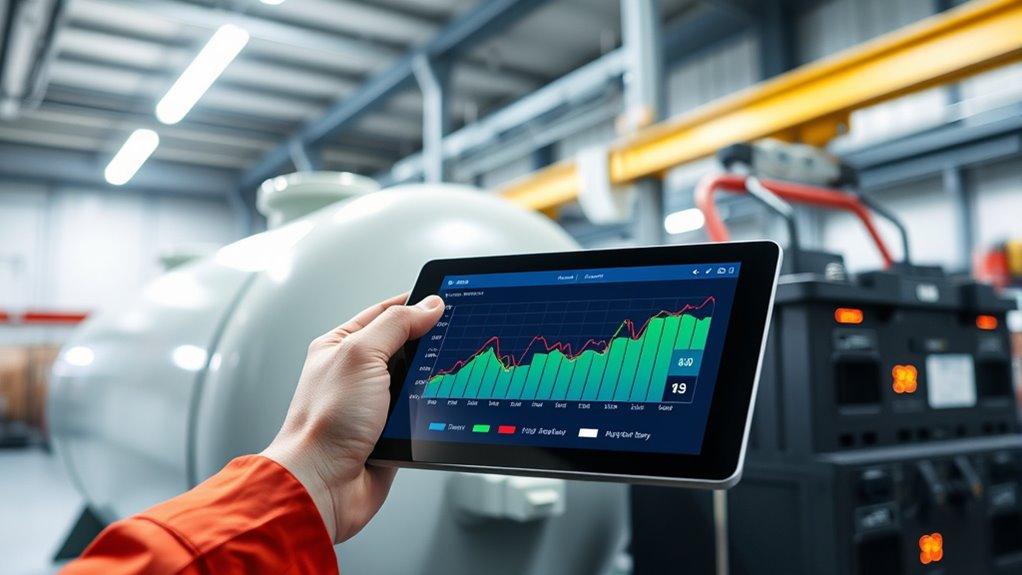
Monitoring and verifying battery runtime estimates requires a multi-faceted approach that combines different measurement techniques. Start by tracking voltage and current under load, which reveals real-time battery behavior, but remember that voltage alone isn’t enough for accurate estimates. Use Coulomb counting to monitor charge flow, calibrating periodically with full charge-discharge cycles to maintain accuracy. Incorporate load cycling tests to simulate actual usage, confirming whether predicted runtime matches real performance. Quick impedance tests can identify internal resistance changes affecting capacity, while fault injection helps verify system responses under stress. Logging data continuously and comparing it against initial estimates enables you to detect deviations early. Combining these methods provides a thorough overview, ensuring your runtime estimates stay reliable over the battery’s lifespan.
Frequently Asked Questions
How Does Temperature Affect Fuel and Battery Runtime Estimates?
Temperature considerably impacts your fuel and battery runtime estimates. Cold weather reduces battery capacity by slowing chemical reactions, causing lower power output and shorter runtimes. Conversely, high temperatures can temporarily boost capacity but accelerate battery aging, shortening lifespan. For fuel, cold temperatures increase viscosity, reducing efficiency. Always adjust your estimates based on ambient temperature, because extreme cold or heat skews capacity and performance predictions, affecting how long your energy sources last.
What Impact Does Load Variability Have on Actual Runtime?
Load variability decreases your battery’s runtime, causes uneven power draw, and leads to faster chemical depletion. Rapid load changes generate heat, reduce efficiency, and accelerate aging. You’ll experience inconsistent performance, shorter durations, and increased wear if the load fluctuates often. To maximize your battery life, manage load fluctuations carefully, use advanced control strategies, and guarantee proper thermal regulation, helping your device run longer despite variable demands.
How Often Should Runtime Estimates Be Recalculated for Accuracy?
You should recalculate runtime estimates whenever your load profile or usage patterns change substantially. Frequent updates, especially during high-frequency load testing, improve accuracy. For most systems, periodic recalculations—ranging from real-time in electronics to weekly in larger setups—are necessary. Always update estimates after hardware changes, battery replacements, or environmental shifts like temperature changes. Regular recalibration ensures your predictions remain reliable, reflecting current operating conditions and battery health.
Can Runtime Estimates Account for System Inefficiencies or Aging Components?
Yes, your runtime estimates can account for system inefficiencies and aging components. You need to incorporate real-world factors like charging and discharging losses, heat, and internal resistance into your models. Regularly evaluate the battery’s state of health (SOH) and update your estimates accordingly. Using advanced algorithms and dynamic simulation tools helps you adjust predictions, making them more accurate and reflective of actual performance over time.
How Do Safety Margins Influence Total Fuel or Battery Capacity Requirements?
Safety margins directly increase your total fuel or battery capacity needs by adding extra reserves to handle uncertainties and unexpected conditions. They guarantee your system can operate safely during load variations, environmental changes, or component aging. While larger margins improve reliability, they also lead to oversizing, higher costs, and reduced efficiency. Balancing these margins carefully helps you optimize capacity, ensuring safety without unnecessary resource overuse or expense.
Conclusion
Remember, accurate runtime estimates are key to reliable system planning. By understanding your tank or battery capacity and factoring in real-world conditions, you can make smarter decisions. Keep in mind the adage, “Measure twice, cut once”—it’s better to double-check your calculations than deal with unexpected downtime later. Stay diligent in monitoring and adjusting your estimates to guarantee your systems run smoothly and efficiently whenever you need them most.

